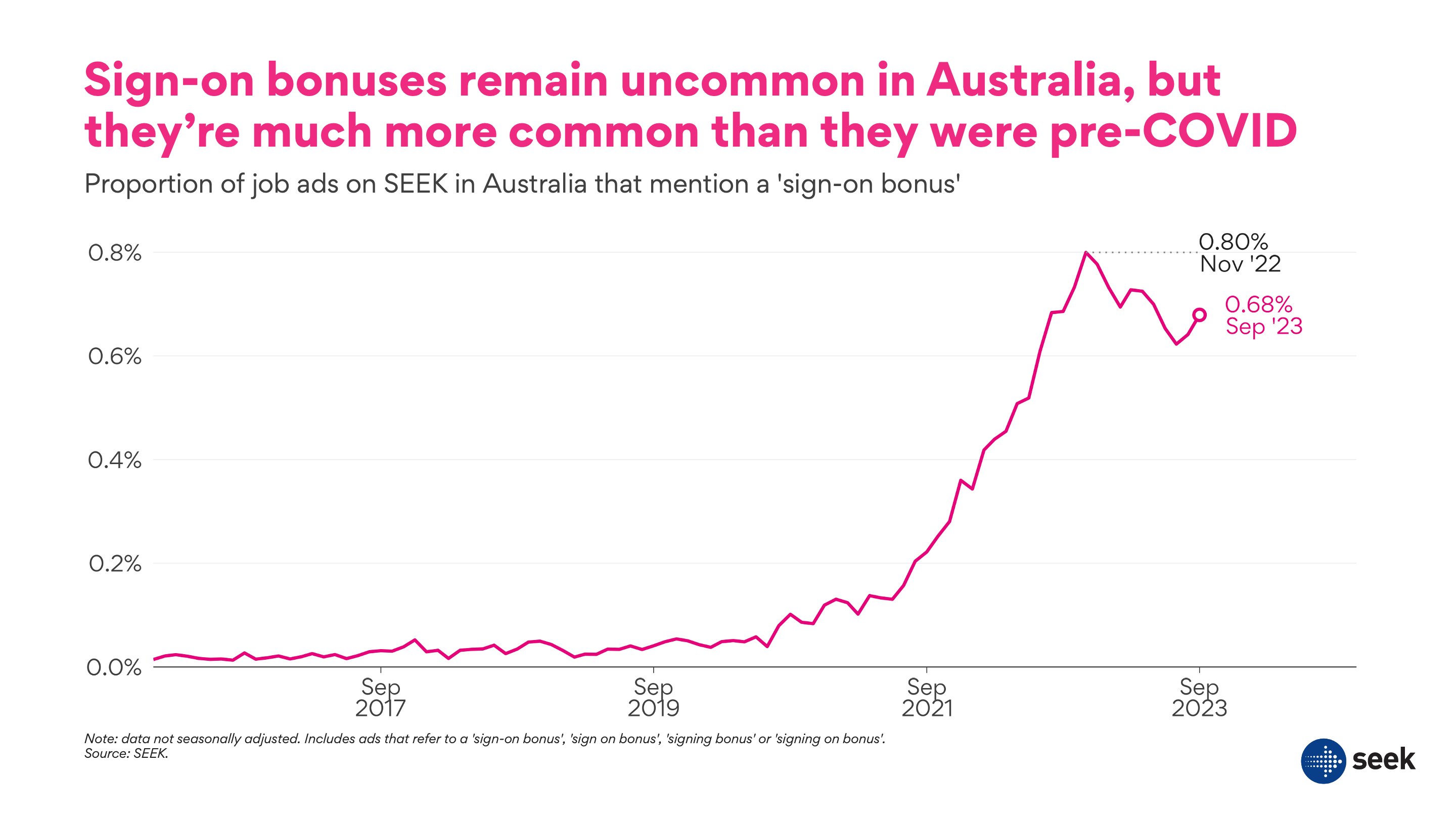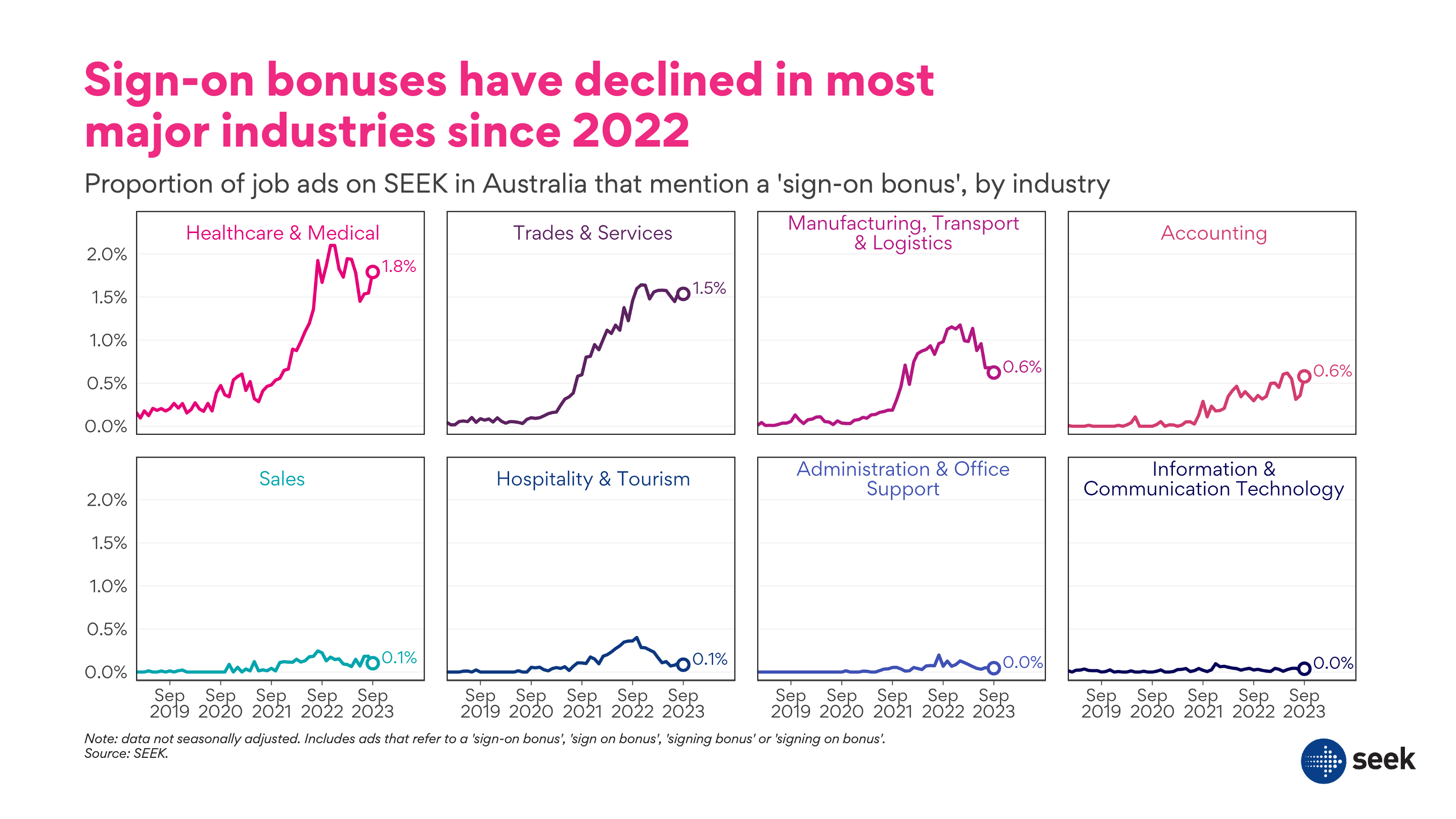Economist Insights
Sign-on bonuses surged during the Great Jobs Boom, but are becoming rarer again
As workers have become easier to find, sign-on bonuses have receded
Sign-on bonuses haven’t traditionally been common in Australia. In 2019, before COVID hit, only around 0.04% of job ads on SEEK in Australia mentioned a sign-on bonus[1] — and if you’re offering a sign-on bonus it’d be a strange decision to not mention it in the job ad. That’s around one in every 2,500 job ads, making sign-on bonuses extremely rare back in the pre-COVID era.
Things changed in the jobs boom of 2021-2022. Workers were very hard to find, with the average number of applications per job ad on SEEK plunging to very low levels. On average, job ads in mid-2022 received less than half the number of applications that ads received in February 2020, which sent hirers scrambling to try to find ways to stand out in the market.
Employers responded to this tight labour market with a range of incentives, including sign-on bonuses in some cases. By November 2022, around 0.8% of all job ads on SEEK in Australia mentioned a sign-on bonus – that’s a rise from one in 2,500 ads pre-COVID to one in every 125 job ads in late 2022.
[1] We searched the full text of all Australian job ads on SEEK for the phrases “sign-on bonus”, “sign on bonus”, “signing bonus” and “signing on bonus”. Any ad containing at least one of those phrases is included as an ad offering a sign-on bonus.

The labour market in 2023 is not as tight as it was in 2022. The number of jobs advertised each month has fallen, and the average number of applications per job ad has risen quite sharply from the lows of 2022. Employers are now finding it easier to attract applicants for their vacant roles, so the need to offer sign-on bonuses has subsided.
As at September 2023, 0.68% of job ads mentioned a sign-on bonus — that’s around one in every 150 ads. Sign-on bonuses have declined modestly since their peak, but they remain much more common than they were before COVID. Even though the average number of applications-per-ad is near its pre-COVID level, sign-on bonuses remain much more common than they were pre-COVID.
Sign-on bonuses down, but still above pre-COVID levels, in most industries
Most major industries have seen a decline in the proportion of job ads mentioning a sign-on bonus in 2023 – a relatively minor decline in the case of the Healthcare & Medical industry to a sharper decline in Manufacturing, Transport and Logistics. Sign-on bonuses in Hospitality & Tourism have almost entirely disappeared.

The healthcare industry dominates the list of jobs in which sign on bonuses are most common. As at September 2023, these are jobs in which sign-on bonuses were most commonly-offered:
- Healthcare & Medical: General Practitioners
- Manufacturing, Transport & Logistics: Public Transport & Taxi Services
- Healthcare & Medical: Optical
- Healthcare & Medical: Nursing - Psych, Forensic & Correctional Health
- Trades & Services: Air Conditioning & Refrigeration[1]
These roles don’t have much in common – some are higher paid, some lower paid. Most, however, tend to require in-person work – it’s possible that some employers are using sign-on bonuses to attract applicants to in-person jobs that might otherwise be less attractive than roles that allow people to work from home at least some of the time.
COVID created enormous disruptions to the Australian labour market – first as the world of work adapted to lockdowns and restrictions, and then as the market boomed in 2021-22. The boom in sign-on bonuses – albeit from a low base – is an example of how employers have adapted to this evolving market. As conditions come back towards something that looks more like the pre-COVID normal, employers will undoubtedly continue to adapt – and we may see sign-on bonuses go back to being the rarity they once were.
[1] Based on a 3-month moving average of non-seasonally adjusted data. Only job types with 50 or more total job ads per month are included.
-ENDS-
About Matt Cowgill
Matt Cowgill is SEEK’s Senior Economist, a position he has held since late 2021. At SEEK, Matt focuses on leveraging SEEK’s unique data to develop insights about the labour market.
Matt’s experience in analysing the labour market has been developed at Grattan Institute, the International Labour Organization, the Victorian Government and elsewhere.
Matt has a Masters in Economic Policy from the University of London, and undergraduate degrees in economics and political science from the University of Western Australia.